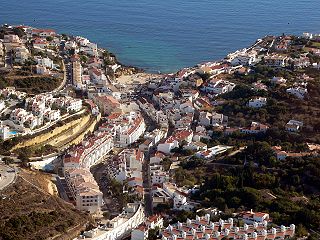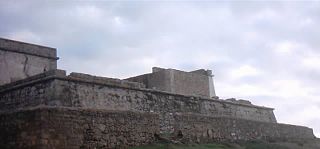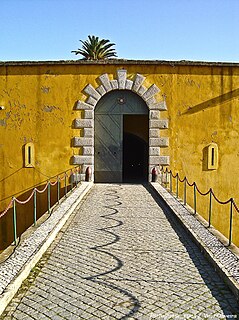Related Research Articles

Chaves is a city and a municipality in the north of Portugal. It is 10 km south of the Spanish border and 22 km south of Verín (Spain). The population in 2011 was 41,243, in an area of 591.23 km2. The municipality is the second most populous of the district of Vila Real. With origins in the Roman civitas Aquæ Flaviæ, Chaves has developed into a regional center. The urban area has 17,535 residents (2001).

Sacavém is a former civil parish in the municipality of Loures, Lisbon District, Portugal. In 2013, the parish merged into the new parish Sacavém e Prior Velho. It is a few kilometers north-east of the Portuguese capital, Lisbon. The civil parish covers an area of 4.09 km2 (1.6 sq mi), and included as of 2001 census a resident population of 17,659 inhabitants. The region is known for its famous ceramics industry.

Vila do Porto is the single municipality, the name of the main town and one of the civil parishes on the island of Santa Maria, in the Portuguese archipelago of Azores. Its nearest neighbor, administratively, is the municipality of Povoação on the southern coast of São Miguel, and it is physically southwest of the islets of the Formigas. The population in 2021 was 5,408, in an area of 96.89 km2 (37.41 sq mi).
Caparica is a former civil parish in the municipality (concelho) of Almada, Lisbon metropolitan area, Portugal. In 2013, the parish merged with the civil parish of Trafaria into the new parish Caparica e Trafaria. The population in 2011 was 20,454, in an area of 11.02 km2.

The Sanctuary of Christ the King is a Catholic monument and shrine dedicated to the Sacred Heart of Jesus Christ overlooking the city of Lisbon situated in Almada, in Portugal. It was inspired by the Christ the Redeemer statue of Rio de Janeiro, in Brazil, after the Cardinal Patriarch of Lisbon visited that monument. The project was inaugurated on 17 May 1959. The giant statue was erected to express gratitude because the Portuguese were spared the direct destructive effects of World War II.

Amora is a civil parish, in the municipality of Seixal in the district of Setúbal, Portugal. It is part of the Lisbon metropolitan area. The population in 2011 was 48,629, in an area of 24.36 km².

The Fort of São Sebastião de Caparica also known as the Tower of São Sebastião or Fortress of the Old Tower is a medieval fortification located in Monte da Caparica, civil parish of Caparica, in the municipality of Almada, in the Portuguese central region of Península de Setúbal.

The Fort of Nossa Senhora da Rocha is a medieval castle situated in the civil parish of Porches, in the municipality of Lagoa in Portuguese Algarve. Inside the fort is the Chapel of Nossa Senhora da Rocha, of uncertain date.

The Fort of Our Lady of the Incarnation is a small fortification in the civil parish of Carvoeiro, municipality of Lagoa, in Portuguese Algarve.

The Fort Nossa Senhora da Queimada also knows as Fort of Pessegueiro is a fort situated along the coast of the civil parish of Porto Covo, municipality of Sines, in the southern Alentejo of Portugal, across from the island of the same name.

The Citadel of Cascais is a set of fortifications built between the 15th and 17th centuries to defend the Cascais coastline and River Tagus estuary and to protect against attacks on the capital of Portugal, Lisbon. The citadel incorporates three separate developments, the tower of Santo António de Cascais, the Fortress of Our Lady of Light, and the former Royal Palace area.

The Fort of São Lourenço do Bugio, also known as the fort of São Lourenço da Cabeça Seca or simply Torre do Bugio, is located in the middle of the estuary of the river Tagus, near Lisbon in Portugal. With no further need for its military functions, it is presently a lighthouse. The fort’s location is on a sandbank formed by the silting of the river mouth, the result of the meeting of the river’s waters with those of the Atlantic Ocean. Being the only sandbar in the Tagus with its surface above the tide throughout the year, it was given the name “dry head”. The derivation of the name “Bugio” (monkey) is uncertain but may be related to the French word for candle, “bougie”, due to the similarity of the fort’s structure with a candle on a candlestick.

The Fort Nossa Senhora da Luz, also known locally as Castle of Senhora da Luz is a fort in the civil parish of Luz, municipality of Lagos in the Portuguese Algarve, classified as a Property of Public Interest.

The Fort of Nossa Senhora da Guia is located in Cascais, Lisbon District in Portugal. It was built during the Portuguese Restoration War (1640-1668), becoming operational in 1646. The site, which preserves some parts of the fort, is now occupied by a maritime laboratory under control of the Faculty of Sciences of the University of Lisbon.

The Fort of São Bruno is situated on the estuary of the River Tagus in Caxias, Oeiras municipality, near Lisbon in Portugal. It was built in 1647 and became operational in 1649 as part of the construction of a line of forts to control access to Lisbon, which stretched from Cabo da Roca on the Atlantic coast to the Belém Tower near Lisbon. The fort is well preserved, following its original design, and is considered one of the most attractive examples of maritime military architecture on the Portuguese coast. It presently serves as the headquarters of the Associação Portuguesa dos Amigos dos Castelos.

The Fort of Giribita, also referred to as the Fort of Our Lady of Porto Salvo and the Fort of Ponta do Guincho, is located on the right bank of the Tagus estuary, in the municipality of Oeiras, District of Lisbon, in Portugal. It was completed in 1649 during the Portuguese Restoration War (1640-1668), as part of the fortifications of Lisbon that stretched from Cabo da Roca on the Atlantic coast to Belém Tower close to Lisbon. It could exchange crossfire with the Fort of São Bruno to its east.

The Fort of Nossa Senhora das Mercês de Catalazete, also known as the Fort of Catalazete, is located on the right bank of the River Tagus estuary in the municipality of Oeiras in the Lisbon District of Portugal. The fort dates back to 1762, when a small battery was erected on a site between the Fort of São Julião da Barra and the Fort of Santo Amaro do Areeiro, with the purpose of strengthening the defence provided by those two forts.

The Fort of Monserrate is a military fortification located in Salvador, Bahia in Brazil. It is also known as the Small Fort of Our Lady of Monserrate. It was known as the Forte de São Felipe from the time of its construction until the 19th century. The Fort of Monserrate was built between the end of the 16th century and early 17th century on the Itapagipe Peninsula. It is "one of the few Brazilian fortifications to retain its original appearance from the late 16th century." The fort is located above the Church and Monastery of Our Lady of Monserrate, one of the oldest church structures in Brazil. The fort was listed as a historic structure by the National Institute of Historic and Artistic Heritage (IPHAN) in 1938.

The Campo Entrincheirado is a group of fortifications built at the end of the 19th century and beginning of the 20th century to protect the Portuguese capital, Lisbon, against invasion. It followed the boundaries of the city at that time.
The Fort of Alto do Duque is located 75 meters above sea level at the southwestern tip of the Monsanto Forest Park, in the parish of Ajuda, in Portugal's capital of Lisbon. Built at the end of the 19th century as part of Lisbon's Campo Entrincheirado defensive ring around the city, with the intention that it, together with the Fort of Bom Sucesso, would defend against attacks along the River Tagus, the fort is now headquarters of the criminal investigation division of the Polícia de Segurança Pública (PSP) in Lisbon.
References
- 1 2 3 4 "Forte de Nossa Senhora da Saúde da Trafaria". Fortalezas.org. Retrieved 25 November 2020.
- 1 2 3 "Forte de Nossa Senhora da Saúde da Trafaria". SIPA: Sistema de Informação para o Património Arquitetónico. Retrieved 25 November 2020.
- ↑ "Forte do Alto do Duque". Fortalezas.org. Retrieved 24 November 2020.
- ↑ "Arquivo de etiquetas: Forte do Alto do Duque: Ainda a 1ª experiência de TSF em Portugal". História das Transmissões Militares. Retrieved 24 November 2020.
- ↑ "Forte da Trafaria renasce como centro de arte e tecnologias da Universidade Nova de Lisboa". Público. Retrieved 25 November 2020.
